House of Mowbray
The House of Mowbray (/ˈmoʊbri/) is an Anglo-Norman noble house, derived from Montbray in Normandy and founded by Roger de Mowbray, son of Nigel d'Aubigny.[1][2]
| House of Mowbray | |
|---|---|
| Noble house | |
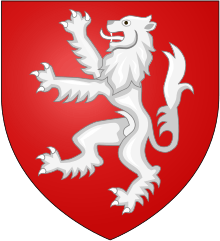 | |
| Country | |
| Founder | Roger de Mowbray[1] |
| Titles | Various |
| Style(s) | Dukes, Earls, Barons, and Knights |
| Estate(s) | Various Dukedoms, Earldoms, and Baronies |
Foundations
Following the Norman conquest of England, Geoffrey de Montbray, bishop of Coutances, was granted some 280 English manors. His heir, his brother Roger's son, Robert de Mowbray, Earl of Northumbria, was forfeited and imprisoned for life on rebelling in 1095.[3] His lands were confiscated and he was forced to divorce his wife, Matilda de L'Aigle, daughter of Richer de L'Aigle, Lord of L'Aigle. His Mowbray lands would pass with her to her new husband, a royal favourite, Nigel d’Aubigny.
Roger d'Aubigny (of Saint-Martin-d'Aubigny) had two sons, Nigel and William, who were ardent supporters of Henry I. They were rewarded by him with great estates in England. William was made king's butler, and was father of William d'Aubigny, 1st Earl of Arundel; Nigel was rewarded with the marriage, by dispensation, with the former the wife of Robert de Mowbray, the imprisoned earl, and with the escheated fief of her former husband in Normandy and a number of lands in England.[1] After a decade of childless marriage, he would divorce Matilda and remarry in 1118 to Gundred de Gournay (died 1155), daughter of Gerard de Gournay, lord of Gournay. They had one son by that marriage, Roger, who took the surname of Mowbray from his major Norman seat.[3][1]
Roger, a great lord with a hundred knight's fees, was captured with King Stephen at the battle of Lincoln, joined the rebellion against Henry II (1173), founded abbeys, and went on crusade. His grandson William, a leader in the rising against King John, was one of the 25 barons of the Magna Carta, as was his brother Roger, and was captured fighting against Henry III at the rout of Lincoln (1217).
Lords Mowbray
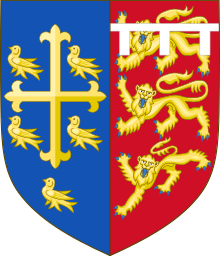
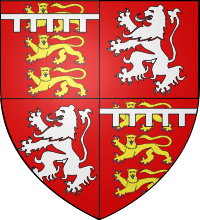
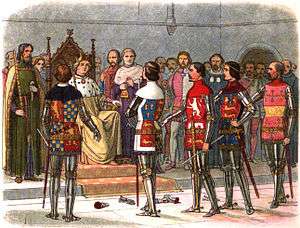
William's grandson Roger de Mowbray (1266–1298), was summoned to parliament by Edward I, by which act he is held to have become the first Lord Mowbray. He was father of John (1286–1322), a warrior and warden of the Scottish March, who, joining in Thomas of Lancaster's revolt, was captured at Boroughbridge and hanged.[3] His wife, a Braose heiress, added Gower in South Wales and the Bramber lordship in Sussex to the great possessions of his house. Their son John de Mowbray, 3rd Baron Mowbray (d. 1361) was father, by Joan of Lancaster, a daughter of Henry, 3rd Earl of Lancaster, of John, Lord Mowbray (c. 1328–1368), whose fortunate alliance with the heiress of John de Segrave, 4th Baron Segrave, by the heiress of Edward I's son Thomas, earl of Norfolk and marshal of England, crowned the fortunes of his race. In addition to a vast accession to their lands, the earldom of Nottingham and the marshalship of England were bestowed on them by Richard II, and the dukedom of Norfolk followed.[3]
The 1st duke left two sons, of whom Thomas the elder was only recognized as earl marshal. Beheaded for joining in Scrope's conspiracy against Henry IV (1405), he was succeeded by his brother John, who was restored to the dukedom of Norfolk in 1424. His son John, the third duke, was father of John, 4th and last duke, who was created earl of Warenne and Surrey in his father's lifetime (1451). At his death (1481) his vast inheritance devolved on his only child Anne, who was married as an infant to Edward IV's younger son Richard (created duke of Norfolk and earl of Nottingham and Warenne), but died in 1481.[3]
The next heirs of the Mowbrays were then the Howards and the Berkeleys, representing the two daughters of the first duke. Between them were divided the estates of the house, the Mowbray dukedom of Norfolk and earldom of Surrey being also revived for the Howards (1483), and the earldom of Nottingham (1483) and earl marshalship (1485) for the Berkeleys. Both families assumed the baronies of Mowbray and Segrave, but Henry Howard was summoned in his father's lifetime (1640) as Lord Mowbray, which was deemed a recognition of the Howards' right; their co-heirs, from 1777, were the Lords Stourton and the Lords Petre, and in 1878 Lord Stourton was summoned as Lord Mowbray and Segrave. The former dignity is claimed as the premier barony, though De Ros ranks before it. Lord Stourton's son claimed, but unsuccessfully, in 1901–1906 the earldom of Norfolk (1312), also through the Mowbrays. Of the Mowbray estates the castle and lordship of Bramber is still vested in the dukes of Norfolk.[3]
The current Baron of Mowbray is Edward Stourton, 27th Baron Mowbray, 28th Baron Segrave and 24th Baron Stourton (1953–present).
Notable Mowbray family members
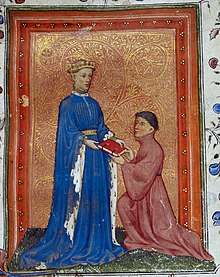
- Nigel d'Aubigny, lord of Mowbray (d.1129)
- Roger de Mowbray, lord of Mowbray (d.1188)
- Roger de Mowbray, 1st Baron Mowbray (d.1298)
- John de Mowbray, 2nd Baron Mowbray (d.1322)
- John de Mowbray, 3rd Baron Mowbray (d.1361)
- John de Mowbray, 4th Baron Mowbray (d.1368)
- John Mowbray, 1st Earl of Nottingham, 5th Baron Mowbray (d.1383)
- Thomas Mowbray, 1st Duke of Norfolk, Earl of Nottingham and Norfolk, Baron Segrave and 6th Baron Mowbray (d.1399)
- Thomas Mowbray, 4th Earl of Norfolk, Earl of Nottingham, Baron Segrave and 7th Baron Mowbray (d.1405)
- John Mowbray, 2nd Duke of Norfolk, Earl of Norfolk, Baron Segrave and 8th Baron Mowbray (d.1432)
- John Mowbray, 3rd Duke of Norfolk, Earl of Nottingham and Norfolk, Baron Segrave and 9th Baron Mowbray (d.1461)
- John Mowbray, 4th Duke of Norfolk, Earl of Nottingham, Norfolk, Surrey and Warenne, Baron Segrave and 10th Baron Mowbray (d.1476)
Notes
- Clay, C., & Greenway, D. E. (2013). Early Yorkshire Families (Vol. 135). Cambridge University Press.
- de Aragon, R. (1982). The growth of secure inheritance in Anglo-Norman England. Journal of Medieval History, 8(4), 381-391.
- Round 1911, p. 948.
References
- Oxford Dictionary of National Biography, Oxford University Press:
- Hugh M. Thomas, “Mowbray, Sir Roger (I) de (d. 1188)”, 2004
- James Tait, revised by Hugh M. Thomas, “Mowbray, William de (c.1173–c.1224)”, online version, October 2005
- Rowena E. Archer, “Mowbray, John (I), second Lord Mowbray (1286–1322)”, online version, January 2008
- Rowena E. Archer, “Mowbray, John (II), third Lord Mowbray (1310–1361)”, 2004
- Rowena E. Archer, “Mowbray, John (III), fourth Lord Mowbray (1340–1368)”, online version, January 2008
- Rowena E. Archer, “Mowbray, John (V), second duke of Norfolk (1392–1432)”, online version, January 2008
- Rowena E. Archer, “Mowbray, Thomas (II), second earl of Nottingham (1385–1405)”, online version, January 2008
Attribution:

Further reading
- Greenway, D.E. (ed.), Charters of the Honour of Mowbray 1107–1191, London, 1972
- Roberts, Gary B[oyd]., “The Mowbray Connection” (in three parts), The Connecticut Nutmegger: Part One, Vol. 10, No. 1 (June 1977), pp. 3–12; Part Two, Vol. 10, No. 2 (September 1977), pp. 187–198; and Part Three, Vol. 10, No. 3 (December 1977), pp. 393–400. This series is the summary of the original manuscript, which runs for twenty-three volumes. The paper itself is available for research at the New England Historic Genealogical Society in Boston, with copies at the New York Public Library in New York City and the Society of Genealogists in London. It does have an index, completed in 1983, but it is not yet available online.
- Roberts, Marilyn, The Mowbray Legacy (Gainsborough, England: Babash Ryan, 2004). ISBN 1-904706-11-8. This book was revised in 2012. For more information, see the website of the revised book's publisher, Queens-Haven Publications.
External links
- Coat-of-arms, Mowbray, St James' Church, High Melton, Yorkshire, Flickr.com
- Charles Cawley, “Chapter 3. Albini (Aubigny)”, Medieval Lands: A propsography of medieval European noble and royal families, for the Albini (Aubigny) side in Normandy.
- Charles Cawley, “E. Dukes of Norfolk (Mowbray)”, Medieval Lands: A propsography of medieval European noble and royal families, for the Mowbray side in England.